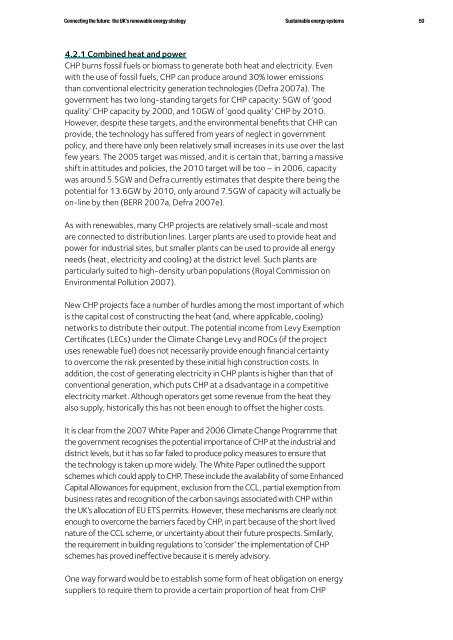Connecting the Future - Greenpeace UK
Connecting the Future - Greenpeace UK
Connecting the Future - Greenpeace UK
You also want an ePaper? Increase the reach of your titles
YUMPU automatically turns print PDFs into web optimized ePapers that Google loves.
<strong>Connecting</strong> <strong>the</strong> future: <strong>the</strong> <strong>UK</strong>’s renewable energy strategy<br />
Sustainable energy systems<br />
50<br />
4.2.1 Combined heat and power<br />
CHP burns fossil fuels or biomass to generate both heat and electricity. Even<br />
with <strong>the</strong> use of fossil fuels, CHP can produce around 30% lower emissions<br />
than conventional electricity generation technologies (Defra 2007a). The<br />
government has two long-standing targets for CHP capacity: 5GW of ‘good<br />
quality’ CHP capacity by 2000, and 10GW of ‘good quality’ CHP by 2010.<br />
However, despite <strong>the</strong>se targets, and <strong>the</strong> environmental benefits that CHP can<br />
provide, <strong>the</strong> technology has suffered from years of neglect in government<br />
policy, and <strong>the</strong>re have only been relatively small increases in its use over <strong>the</strong> last<br />
few years. The 2005 target was missed, and it is certain that, barring a massive<br />
shift in attitudes and policies, <strong>the</strong> 2010 target will be too – in 2006, capacity<br />
was around 5.5GW and Defra currently estimates that despite <strong>the</strong>re being <strong>the</strong><br />
potential for 13.6GW by 2010, only around 7.5GW of capacity will actually be<br />
on-line by <strong>the</strong>n (BERR 2007a, Defra 2007e).<br />
As with renewables, many CHP projects are relatively small-scale and most<br />
are connected to distribution lines. Larger plants are used to provide heat and<br />
power for industrial sites, but smaller plants can be used to provide all energy<br />
needs (heat, electricity and cooling) at <strong>the</strong> district level. Such plants are<br />
particularly suited to high-density urban populations (Royal Commission on<br />
Environmental Pollution 2007).<br />
New CHP projects face a number of hurdles among <strong>the</strong> most important of which<br />
is <strong>the</strong> capital cost of constructing <strong>the</strong> heat (and, where applicable, cooling)<br />
networks to distribute <strong>the</strong>ir output. The potential income from Levy Exemption<br />
Certificates (LECs) under <strong>the</strong> Climate Change Levy and ROCs (if <strong>the</strong> project<br />
uses renewable fuel) does not necessarily provide enough financial certainty<br />
to overcome <strong>the</strong> risk presented by <strong>the</strong>se initial high construction costs. In<br />
addition, <strong>the</strong> cost of generating electricity in CHP plants is higher than that of<br />
conventional generation, which puts CHP at a disadvantage in a competitive<br />
electricity market. Although operators get some revenue from <strong>the</strong> heat <strong>the</strong>y<br />
also supply, historically this has not been enough to offset <strong>the</strong> higher costs.<br />
It is clear from <strong>the</strong> 2007 White Paper and 2006 Climate Change Programme that<br />
<strong>the</strong> government recognises <strong>the</strong> potential importance of CHP at <strong>the</strong> industrial and<br />
district levels, but it has so far failed to produce policy measures to ensure that<br />
<strong>the</strong> technology is taken up more widely. The White Paper outlined <strong>the</strong> support<br />
schemes which could apply to CHP. These include <strong>the</strong> availability of some Enhanced<br />
Capital Allowances for equipment, exclusion from <strong>the</strong> CCL, partial exemption from<br />
business rates and recognition of <strong>the</strong> carbon savings associated with CHP within<br />
<strong>the</strong> <strong>UK</strong>’s allocation of EU ETS permits. However, <strong>the</strong>se mechanisms are clearly not<br />
enough to overcome <strong>the</strong> barriers faced by CHP, in part because of <strong>the</strong> short lived<br />
nature of <strong>the</strong> CCL scheme, or uncertainty about <strong>the</strong>ir future prospects. Similarly,<br />
<strong>the</strong> requirement in building regulations to ‘consider’ <strong>the</strong> implementation of CHP<br />
schemes has proved ineffective because it is merely advisory.<br />
One way forward would be to establish some form of heat obligation on energy<br />
suppliers to require <strong>the</strong>m to provide a certain proportion of heat from CHP




![[2007] EWHC 311 - Greenpeace UK](https://img.yumpu.com/22079793/1/184x260/2007-ewhc-311-greenpeace-uk.jpg?quality=85)











